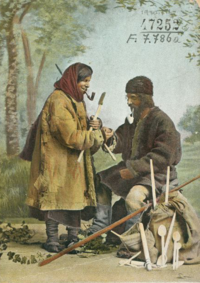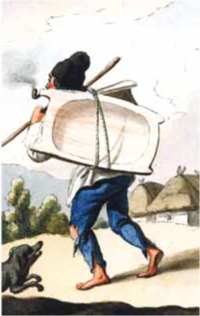Boyash
You can helpexpand this article with text translated fromthe corresponding articlein Romanian.(January 2023)Click [show] for important translation instructions.
|
This articleneeds additional citations forverification.(October 2022) |
| Total population | |
|---|---|
| ≈ 14,000[1] |
BoyashorBayash(endonym:Bȯjáṡ,Romanian:Băieși,Hungarian:Beás,Slovak:Bojáš,South Slavic:Banjaši,Bojaši) are aRomaniethnic group living inRomania,southernHungary,northeastern and northwesternCroatia,westernVojvodina,Slovakia,theBalkans,but also in theAmericas.[2]Alternative names areRudari(Ludari),LingurariandZlătari.[3]
History[edit]
This sectionneeds additional citations forverification.(January 2023) |

The Boyash or Băieși (in Romanian) are a branch/casteof the Roma who were forced to settle in the 14th century in theApuseni Mountains,located inTransylvania,and work asslavesinmining(a regionalism forminein Romanian: "baie," from Middle AgeSlavonic).[4][page needed]
At the end of the 16th century the Boyash started migrating towards the south, inWallachia,and the east, inMoldavia,where they were held as slaves together with other Romani groups (until theslaverywas abolished in 1855–56).[4][page needed]
Another name for the Boyash,Rudari,comes from theSlavicruda( "metal", "ore" ). As the mines became inefficient, the Boyash people were forced to readjust by earning their living makingwoodutensils(Lingurarimeans "spoon-makers "in Romanian; also cf.Serbianruda,Hungarianrúd,Romanianrudămeaning "relative", but also "rod, pole, stick" ). The nicknameKashtale( "wood-workers" ) was also given to them by the Romani-speaking Roma and it has remained in Romani as a more general word for a Rom who does not speak Romani.[4][page needed] After the point at which they began to make wood tools they scattered themselves in isolated communities. The consequence of this is that nowadays they speak a distinct archaic dialect of Romanian, with borrowings from other surrounding languages.[4][page needed]
Population[edit]

After the liberation of the Roma from slavery (by the middle of the 19th century), manyemigratedto other countries, especiallyHungaryandthe Balkans,but also as far as theAmericas,South AfricaandAustralia.[5]
In 1993, about 14,000 of the 280,000 recorded Hungarian Roma were Boyash.[6]
InCroatia,the Boyash are settled in several small communities along the Hungarian border in the regions ofMeđimurje,the Podravina,SlavonijaandBaranjawith an overflow of settlers living in theApatincounty ofVojvodina,Serbia.[7]2005 saw the Boyash language of Croatia published in its ownalphabetfor the first time in theCatholic Catechism,published by the HBK Glas Koncila in Zagreb.[8]In 2007, the first Bible—a children's Bible—was published by OM EAST in Austria and facilitated by The Romani Bible Union.[9]
Names in other languages[edit]
In English, the commonly accepted name for the ethnic group isBoyash,however in contemporaryBulgariathe termsLudariandRudariare in common use, while inRomaniaboth terms are present in some form:RudariandBăieși.[10]
For the same ethnic group inHungaryandCroatiathe termsBeyashandBayash(Bajaši) are now officially used.[11]The ethnonymBanyash( "miner" ) inSerbiais known only among the group settled inBačkaregion, living along the riverDanube,near the border withCroatiaandHungary.[12]This term is only sporadically understood, and not used among some otherBanyashgroups in theSerbian Banatregion, e.g. the village ofUljma.[13]
They are also known by many appellations based on trades; in addition to Rudari/Ludari ( "miners", from Serbian and Bulgarianruda"ore, metal" ) they are known asKopanari( "cradle-makers", from Serbian and Bulgariankopanja"wooden box" ),Koritari( "trough-makers" ),Lingurara( "spoon-makers", cf. Romanianlingură"spoon" ) andUrsari(cf. Romanianurs"bear" ) orMechkara( "bear-trainers" ).[14]
Education[edit]
Education in theRomanian languageis available only for the Banyash living inRomanianvillages in the SerbianBanat,as well as in Hungary, in the subdialect of the Romanian language spoken by Boyash communities in (central and western) Hungary.[15]
During the last few years there have been several attempts on behalf of local non-governmental organizations in East Bačka region to introduce optional classes inRomanian.[16]According to 2004 field research data, only two such projects are still going on there: optional classes inRomanianin the village ofVajska,and kindergarten in the local Ardeal dialect inBački Monoštor,attended by 20 pupils altogether.[17]
References[edit]
Notes
- ^Kenrick, Donald (2007).Historical dictionary of the Gypsies (Romanies)(2nd ed.). Lanham, Md.: Scarecrow Press.ISBN978-0-8108-6440-5.OCLC263614930.
- ^"The Ludar".www.smithsonianeducation.org.
- ^Smith, David James (2016-06-16).Only Horses from Wild.Lulu.com.ISBN9781365197734.
- ^abcdOrsós, Anna; Kálmán, László (2009).Beás nyelvtan[Boyash Hungarian Gypsy Language Grammar] (in Hungarian). Budapest: MTA nyelvtudományi Tinta.ISBN9789639902251.OCLC895419776.
- ^Liégeois, Jean-Pierre; Europe, Council of (January 2007).Roma in Europe.Council of Europe.ISBN9789287160515.
- ^Kenrick, Donald (2007).Historical dictionary of the Gypsies (Romanies)(2nd ed.). Lanham, Md.: Scarecrow Press.ISBN978-0-8108-6440-5.OCLC263614930.
- ^Bódi, Zsuzsanna (1997).Studies about Boyash Gypsies in Hungary.Magyar Néprajzi Társaság.ISBN9789630387828.
- ^Bódi, Zsuzsanna (1997).Studies about Boyash Gypsies in Hungary.Magyar Néprajzi Társaság.ISBN9789630387828.
- ^"Bibles for Communist Europe – A Cold War Story – Part I - Hungarian Review".www.hungarianreview.com.
- ^Liégeois, Jean-Pierre (January 2012).The Council of Europe and Roma: 40 Years of Action.Council of Europe.ISBN9789287169457.
- ^Miskovic, Maja (2013-07-18).Roma Education in Europe: Practices, policies and politics.Routledge.ISBN9781136280658.
- ^Kállai, Ernő (2002).The Gypsies/The Roma in Hungarian Society.Teleki László Foundation.ISBN9789638577467.
- ^Sikimić, Biljana (2005).Banjaši na Balkanu: Identitet etničke zajednice.Balkanološki institut SANU.ISBN9788671790482.
- ^Guy, Will (2001).Between Past and Future: The Roma of Central and Eastern Europe.ISBN9781902806075.
- ^Cf. a (.pdf) paper issued by the Hungarian ministry of education (as of May 25, 2006) containing the official schools curriculum for Boyash pupils, reading, writing and the type of tests and examinations in their language, which is based on the Romanian subdialects spoken in westernTransylvania(esp. inCrișana) andBanat,containing numerous borrowings from the Hungarian language; the script is an adaptation based on Hungarian and Romanian graphems:"Beás nyelv emelt szintű írásbeli vizsga, 2006"(PDF).Archived fromthe original(PDF)on 2012-03-17.Retrieved2011-03-29..
- ^Sutherland, Anne (July 1986).Gypsies: The Hidden Americans.ISBN9781478610410.
- ^Kontra, Mikl¢s (January 1999).Language, a Right and a Resource: Approaching Linguistic Human Rights.ISBN9789639116641.
Bibliography
- Kemény, István: The Structure of Hungarian Roma Groups in Light of Linguistic Changes
- Biljana Sikimić,Linguistic Research of Small Exogamic Communities: the Case of Banyash Roumanians in Serbia
- Hancock, Ian.The Pariah Syndrome1987.
- Kahl, Thede. "The Rudari in Greece."Sorescu-Marinković, Annemarie, Kahl, Thede; Sikimić, Biljana (eds.). Boyash Studies: Researching “Our People”.Frank & Timme: Berlin 2021, Forum: Rumänien 40: 193-212.
- Marushiakova et al.Identity Formation among Minorities in the Balkans: The cases of Roms, Egyptians and Ashkali in Kosovo
- Orsós, Anna. "The Boyash in Hungary: Linguistic Situation, Language Education and Teacher Training."Sorescu-Marinković, Annemarie, Kahl, Thede; Sikimić, Biljana (eds.): Boyash Studies: Researching “Our People”.Frank & Timme: Berlin 2021, Forum: Rumänien 40: 215.
- Orsós, Anna, and Eszter Gergye. "The linguistic situation of the Boyash language in Hungary."Studia Romanica et Anglica Zagrabiensia: Revue publiée par les Sections romane, italienne et anglaise de la Faculté des Lettres de l’Université de Zagreb66 (2021): 169-176.
- Orsós, Anna and László KálmánBeás nyelvtan(Boyash Grammar [in Hungarian]) Tinta Publishing 2009ISBN9789639902251
- Kahl, Thede; Sikimić, Biljana; Sorescu-Marinković, Annemarie (eds.). Boyash Studies: Researching “Our People”.Frank & Timme: Berlin 2021, Forum: Rumänien 40.
Studies about Boyash Gypsies in HungaryStudies about Boyash Gypsies in Hungary book Google Books Zsuzsanna Bódi - 1997
External links[edit]
- Boyash/Rudari Collectionat the "Vanishing Languages and Cultural Heritage" Commission, Austrian Academy of Sciences "with recordings by Thede Kahl and Ioana Nechiti
- Kahl, Thede: Nechiti, Ioana 2019: The Boyash in Hungary: A Comparative Study Among the Argeleni and Munceni Communities (pdf download)
- Kovalcsik, Katalin 1996: Roma or Boyash Identity? The Music of the "Ard'elan" Boyashes in Hungary
- Orsós, Anna: Boyash in Hungary; in Sorescu-Marinkovic; Kahl, Thede; Sikimic, Biljana 2022: Boyash Studies: Researching “Our People”
- The Gypsies/The Roma in Hungarian Society
